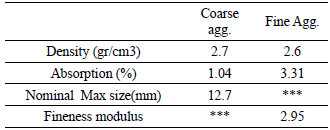Services on Demand
Journal
Article
Indicators
-
 Cited by SciELO
Cited by SciELO -
 Access statistics
Access statistics
Related links
-
 Cited by Google
Cited by Google -
 Similars in
SciELO
Similars in
SciELO -
 Similars in Google
Similars in Google
Share
DYNA
Print version ISSN 0012-7353On-line version ISSN 2346-2183
Dyna rev.fac.nac.minas vol.79 no.171 Medellín Jan./Feb. 2012
EFFECT OF SILICA FUME ADDITION ON THE CHLORIDE-RELATED TRANSPORT PROPERTIES OF HIGH-PERFORMANCE CONCRETE
EFECTO DE LA ADICIÓN DE MICROSILICE SOBRE LOS CLORUROS RELACIONADA CON LAS PROPIEDADES DE TRANSPORTE EN EL CONCRETO DE ALTO DESEMPEÑO
JUAN LIZARAZO-MARRIAGA
Ph.D. Universidad Nacional de Colombia, Bogotá, Colombia, jmlizarazom@unal.edu.co
LUCIO GUILLERMO LÓPEZ YÉPEZ
Ms.C. Universidad Nacional de Colombia, Bogotá, Colombia, lglopezy@unal.edu.co
Received for review May 10th, 2011, accepted November 22th, 2011, final version December, 19th, 2011
ABSTRACT: Being the corrosion of steel reinforcement due to chloride penetration the major cause of durability problems in concrete, this paper summarizes the results of an experimental research carried out in order to investigate the influence of the silica fume (SF) content on some chloride-related transport properties. To achieve this, the compressive strength, the self-diffusion chloride penetration, the charge passed in a non-steady chloride migration test (ASTM C1202), and the AC resistivity were measured on concrete mixes of high-performance concrete. Four concrete mixes were cast incorporating 5, 10, and 15% of SF as an addition to ordinary Portland cement. The results showed that the silica fume in concrete causes an increase in strength and a reduction in chloride ion permeability; however, clear differences were found between the results of long diffusion and rapid electrical tests.
KEYWORDS: chloride ions, high-performance concrete, silica fume, transport properties
RESUMEN: La corrosión del acero de refuerzo, debido a la penetración de cloruro es la principal causa de problemas de durabilidad en el concreto. De esta forma, este documento resume los resultados de un estudio experimental llevado a cabo con el fin de investigar la influencia del contenido de microsilice (SF) en los cloruros relacionados con algunas propiedades de transporte del concreto. Para ello, la resistencia a la compresión, la penetración de cloruros libres por difusión, la carga pasada bajo un ensayo de migración de cloruros no estacionario (ASTM C1202) y la resistividad AC, se midieron en las mezclas de concreto de alto desempeño. Cuatro mezclas de hormigón se hicieron incorporando 5, 10, y el 15% de SF, como adición al cemento Portland. Los resultados mostraron que el humo de sílice en el hormigón provoca un aumento en la resistencia y la reducción de la permeabilidad de iones de cloruro, sin embargo se encontraron diferencias claras entre los resultados de los ensayos difusión a largo plazo y las pruebas eléctricas aceleradas.
PALABRAS CLAVE: iones cloruro, concreto de alto desempeño, micro-sílice, propiedades de transporte
1. INTRODUCTION
Silica fume (SF) is a by-product of the reduction of high-purity quartz with coal in electric furnaces in the production of silicon derivates. As a by-product, it has beneficial uses in concrete because of its pozzolanic reactivity, which has been widely used to produce very high-strength and durable concrete. As is reported by many authors, supplementary cementing materials such as SF have a beneficial influence on reinforced concrete durability [1]. Laboratory tests of silica-fume concretes have shown a reduction on concrete water permeability and concrete chloride diffusion coefficients.
Since the corrosion of steel reinforcement due to chloride penetration is the major cause of durability problems in concrete, this paper summarizes the results of an experimental research carried out in order to investigate the influence of the SF content on some chloride-related transport properties. To achieve this, the compressive strength, the self diffusion chloride penetration, the charge passed under a non-steady chloride migration test (ASTM C1202), and the AC resistivity were measured on concrete mixtures incorporating SF.
2. MATERIALS AND EXPERIMENTS
2.1 Materials
An ordinary Portland cement type I (OPC), with no mineral admixtures and a commercial pulverized silica fume were used as cementitious materials. Table 1 shows the chemical composition of silica fume and Fig. 1 shows the particle size analysis for the raw materials used.
Table 1. Chemical composition of SF


Figure 1. Particle size analysis of cementitious materials
Coarse aggregate from a quarry with an angular rough surface texture and natural sand were used for all mixtures. The physical properties of the aggregates are shown in Table 2. In the same way, Fig. 2 shows their particle size distribution.

Figure 2. Coarse and fine aggregate size distribution
Concrete mixtures were cast incorporating 0, 5, 10, and 15% of SF as addition to ordinary Portland cement. This was done in order to determine the effect of SF in concrete mixtures of constant cement content. Four batches of concrete were produced and 10 cylinder specimens with 150-mm diameter and 300-mm heights were cast for each one. Since concrete mixtures with a 0.32 water to cement ratio were produced, it was necessary to apply a high-range water-reducing commercial chemical admixture (based on policarboxilates) in order improve the workability of the concrete mixtures. Table 3 shows a summary of the concrete mix design. After mixing, all test specimens were demoulded at 1 day and then cured in lime water using a constant temperature of 22 ± 2 ºC.
2.1 Tests
For concrete compressive strength tests, the recommendations of ASTM C39 [2] were followed. Experiments at four different ages (7, 28, 90, and 300 days) were carried out, and each result corresponds to the average of three replicates.
The electrical current was measured according to the ASTM C1202-RCPT standard [3]. A D.C. external voltage of 60 volts was applied to a 100 mm diameter and 100 mm-high concrete sample. This concrete specimen was in contact with a solution of sodium hydroxide in the anode and with a solution of sodium chloride in the cathode. The samples were saturated in water before the test according to the standard. During the test, the main parameter measured was the current flow through the concrete for a period of 6 h. The total charge passed (coulombs) is determined by calculating the area under the plot of current (A) vs. time (S). Using the test results and the standard, the chloride ion penetrability can be obtained as is shown in Table 4. The specimens were tested after 240 days of casting and each result corresponded to the average of three replicates per each percentage of silica fume.
Table 4. Chloride ion penetrability based on charge passed (ASTM C1202)
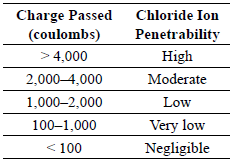
The A.C. resistivity was measured on fully saturated samples before the RCPT tests and by using the two-probes technique. The electrodes were the same cells employed during the RCPT tests including the same solutions of the reservoirs. For this test, an electrical A.C. signal generator and calibrated resistances were used. The voltage applied was between 6 and 8 Volts. This test was conducted using samples that were 240 days old, and three replicates were used.
In order to measure the self diffusion chloride penetration, the cylinders were cut in two halves. The sawn surfaces of these concrete cylinders were placed in contact with a solution of sodium chloride. To prepare the samples, the curved surface of each cylinder was covered with a rubber coating in order to avoid moisture exchange and carbonation during the test. The external concentration of chloride was 7% NaCl and it was renewed every 4 weeks. Figure 3 shows the setup of the test.

Figure 3. Iso-response compressive strength
After 12 weeks of diffusion, the chloride penetration depth was measured using the colorimetric method [4]. Each sample was split axially and sprayed with a solution of 0.1 M silver nitrate. After 15 min, a white silver precipitate on the split surface was visible and the chloride penetration depth was measured. It is assumed that the free chloride concentration at which the colour changes is around 0.07 N for ordinary Portland cement concrete [5]. According to Baroghel-Bouny [6] it can be assumed that the silver nitrate colorimetric technique gives good results when it is necessary to investigate the behaviour of a group of concretes exposed to the same external chloride concentration. It is possible to quantify, compare, and rank mixtures according to the chloride penetration coefficient k of the following equation. The samples were tested at 176 days and 6 replicates were tested for each percentage of silica fume investigated.

3. RESULTS AND DISCUSION
The compressive strength for the mixed combinations of OPC and SF are shown in Fig. 3 as iso-responses or contour curves. It may be noted that, according to the compressive strength results, the material (for any level of addition at 300 days) can be considered to be a high-strength concrete (>80 MPa). Regardless of the level of silica fume addition, at 90 days, the specimens reached at least 85% of the strength obtained at 300 days. Although the optimum level of addition was 10%, there is not an important difference between the compressive strength of this level of replacement and the other levels investigated. The compressive strength for the 10% mixture silica fume is 4% higher than the resistance obtained using 5 and 15% SF. With regard to the 100% OPC sample, the mixture made using 10% SF was 20% higher.
The A.C. electrical resistivity measured on the water saturated cylinder samples just before carrying out the RCPT migration tests is shown in Fig. 4. Mixtures with SF developed higher resistivity compared to the specimens without it, showing huge differences between the results of different levels of addition. Although high resistivity results are an indication of the refinement of the porous matrix and tortuosity of concrete, there are some chemical conditions within the pore solution that could affect the results. For example, the depletion of the OH- concentration of the pore solution due to pozoolanic reactions is believed to affect the results.

Figure 4. Initial AC resistivity measured on SF blended concrete mixtures
The electrical conductivity of the most used aggregates is extremely low and is negligible when compared with the conductivity of the cement paste [7]. The cement paste is formed by different hydration products and for a porosity network full of different ions [8]. In the same way as the aggregates, the hydration products can be considered to be insulators, and consequently, the overall conductivity of concrete is related to the flow of ions on pore solution, which provide the paths of least resistance for electrolytic conduction. The use of mineral and chemical admixtures changes the composition of the pore solution of concrete. Different studies have shown how the use of SF, ground blast furnace slag, metakaoline, and fly ash have a strong effect on the chemical composition and conductivity of the pore solution [9,10].
Figure 5 shows the RCPT results for all SF blended mixtures. The charge passed decreases as the level of addition increases. All samples showed low chloride ion penetrability, except the 15% level of addition, which showed a negligible penetration. It can be argued that for RCPT tests, a similar analysis could be done to the one previously performed for resistivity tests.
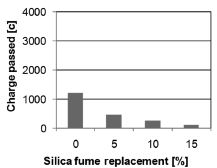
Figure 5. The ASTM C1202 charge passed measured on SF blended concrete mixtures
Results of chloride penetration after 120 days of diffusion are shown in Fig. 6. It can be observed that for the mixtures investigated, the presence of SF has important benefits. Samples containing 15% SF showed the lower value of k, while samples of just OPC showed a higher k value. It is believed that the good chloride resistance of SF blended concretes is due to the high tortuosity and the refinement of the pore structure.
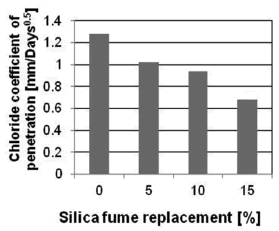
Figure 6. Chloride coefficient of penetration measured on SF-blended concrete mixtures
The good chloride resistance of SF blended concretes has been proven from all tests carried out in this research; however, the benefits from this mineral admixture are distorted in favor of SF when electrical tests, like the resistivity and the RCPT, are used [11].
In order to investigate the distortion induced by electrical tests results, Fig. 7 shows for all experiments carried out (resistivity, RCPT, and self diffusion) a normalized value for all levels of SF addition. That normalized value was obtained as the ratio between the actual results for each level of addition to the result of the same test using a 15% SF addition. It is important to notice that normalized values of different tests should be not compared, but looked at within the same test. Figure 8 gives valuable information. For the chloride coefficient of penetration, it can be seen that the addition of 15% of SF produces an increment on the chloride penetration resistance of about 2 times, while for the RCPT test, the addition of 15% of SF produces an increment on the chloride penetration resistance of about 11 times. For resistivity tests, the addition of 15% of SF produces an increment on the chloride penetration resistance of about 9 times.
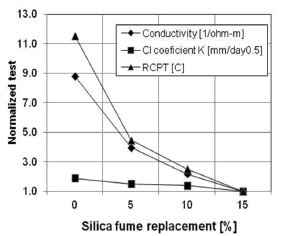
Figure 7. Normalized chloride resistance calculated
4. CONCLUSIONS
- The optimum level of SF addition for compressive strength is 10%, while the best level of replacement which gives the greater chloride resistance is 15% (for the mixtures investigated).
- The chloride-related tests carried out (resistivity, RCPT, and self diffusion) showed that the mixtures evaluated are of high performance concrete. They had high strength and high chloride penetration resistance.
- Electrical tests tend to magnify the benefits of SF and should be carefully analyzed.
REFERENCES
[1] ACI COMMITTEE 234, Guide for the Use of Silica Fume in Concrete, ACI 234R96, 1997. [ Links ]
[2] ASTM C39, Standard Test Method for Compressive Strength of Cylindrical Concrete Specimens, 2010. [ Links ]
[3] ASTM C1202 Standard Test Method for Electrical Indication of Concrete's Ability to Resist Chloride Ion Penetration, 2010. [ Links ]
[4] Meck, E. and Sirivivatnanon, V., Field indicator of chloride penetration depth. Cement and Concrete Research, 33(8), pp. 1113-1117, 2003. [ Links ]
[5] NTBUILD-492, Nordtest method: concrete, mortar and cement-based repair materials: chloride migration coefficient from non-steady-state migration experiments. 1999. [ Links ]
[6] Baroghel-Bouny, V., Belin, P., Maultzsch, M. and Henry, D., 'AgNO3 Spray Tests: Advantages, Weaknesses, and Various Applications to Quantify Chloride Ingress into Concrete. Part 1: Non-Steady-State Diffusion Tests and Exposure to Natural Conditions.' Materials and Structures 40 (8), pp. 759-781, 2007. [ Links ]
[7] Wee, T. H., Suryavanshi, A. K. and Tin, S. S., 'Influence of Aggregate Fraction in the Mix on the Reliability of the Rapid Chloride Permeability Test.' Cement and Concrete Composites, 21 (1), pp. 59-72, 1999. [ Links ]
[8] Marriaga, J. L. and Claisse, P., optimization of the ionic transport related properties of concrete and simulation of the ASTM C1202 test. Revista DYNA, 160, Nro. 160, pp. 185-194. Medellín, Diciembre de 2009. [ Links ]
[9] Page, C. L. and Vennesland, O., 'Pore Solution Composition and Chloride Binding Capacity of Silica-Fume Cement Pastes.' Materials and Structures, 16 (1), pp. 19-25, 1983. [ Links ]
[10] Glasser, Fredrik, Luke and Angus, 'Modification of Cement Pore Fluid Compositions by Pozzolanic Additives' Cement and Concrete Research, 18, (2), pp. 165-178, 1988. [ Links ]
[11] Hooton, R.D., Pun, P., Kojundic, T., Fidjestol, P., Influence of silica fume on chloride resistance of concrete, Proceeding International Symposium of High Performance Concrete, Chicago, (P. Johal, Precast Prestressed Concrete Institute) pp. 245-249, 1997. [ Links ]













